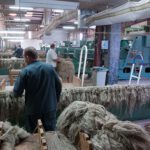About Linen
Learn more about the Characteristics of Linen and the different stages from Flax to Fabric.
Characteristics of Linen
Flax is one of the oldest textile fibers in the world. Since its arrival, flax has always been present in Western Europe because the plant grows best here. Our temperate climate ensures the ideal alternation of sun and rain for a large and strong plant. The longer and stronger the fiber, the better the quality of the linen. More than 75% of flax fibers used worldwide to weave linen fabric come from France, Belgium and the Netherlands.
From Flax to fabrics

THE HARVEST
The flax plant grows best in the north of France, in Belgium and in the Netherlands. This region’s rich soil and mild North Sea climate, where sun and rain alternate, are ideal for growing a fiber that is known worldwide for its quality.
In 2018 about 136 000 acres of flax was sown in Belgium, France and the Netherlands, which represented 80% of the worldwide flax production.

SOWING
The sowing of the flax takes place between Mid-March and Mid-April. Flax is grown according to a crop rotation method, with the rotation renewed every 6 to 7 years, regenerating the soil for the succeeding crops of beet, wheat, potatoes, etc. Today’s flax farmers can choose between the twenty or so varieties available.

FLOWERING
The flax blooms around Mid-June. Many flowers bloom with, 80 to 100 flowers per stem.

PULLING
Pulling occurs about 5 weeks after flowering. Plants are laid on the ground in swathes (layers of flax one meter wide). The flax isn’t cut but is instead pulled up, preserving the length of the fibres contained within its stem

RETTING & BAILING

SCUTCHING
Scutching is an entirely mechanical process, without the use of chemicals, that takes place throughout the year. Facilities for scutching are located in the immediate proximity of the fields. The straws are brought from the farm to the scutching mill by the farmer and then converted into fibre

SPINNING & WEAVING
During preparation, slivers of combed flax are mixed together, blending several batches of fibers originating from different fields, regions and years. Mixed together, equalised and stretched out, the slivers become roving before being spun.

DYEING & FINISHING
Most of our fabrics are dyed in the Far East in a dyeing mill that is run by highly skilled workers who are experienced in producing fabric for Fashion & Home Furnishing Textiles.

QUALITY CONTROL
All of our linen fabric is checked to ensure it meets our highest standards. We work with external testing companies like SGS, Intertek & SGS this to ensure quality is approved before shipment.
